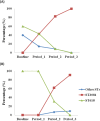Temporal changes in nasopharyngeal carriage of Streptococcus pneumoniae serotype 1 genotypes in healthy Gambians before and after the 7-valent pneumococcal conjugate vaccine
- PMID: 25945306
- PMCID: PMC4419557
- DOI: 10.7717/peerj.903
Temporal changes in nasopharyngeal carriage of Streptococcus pneumoniae serotype 1 genotypes in healthy Gambians before and after the 7-valent pneumococcal conjugate vaccine
Abstract
Streptococcus pneumoniae serotype 1 is one of the leading causes of invasive pneumococcal disease. However, this invasive serotype is hardly found in nasopharyngeal asymptomatic carriage and therefore large epidemiological studies are needed to assess the dynamics of serotype 1 infection. Within the context of a large cluster randomized trial conducted in rural Gambia to assess the impact of PCV-7 vaccination on nasopharyngeal carriage, we present an ancillary analysis describing the prevalence of nasopharyngeal carriage of pneumococcal serotype 1 and temporal changes of its more frequent genotypes. Nasopharyngeal swabs (NPS) were collected before PCV-7 vaccination (December 2003-May 2004) and up to 30 months after PCV-7 vaccination. The post-vaccination time was divided in three periods to ensure an equal distribution of the number of samples: (1) July 2006-March 2007, (2) April 2007-March 2008 and (3) April 2008-Feb 2009. S. pneumoniae serotype 1 were genotyped by MLST. Serotype 1 was recovered from 87 (0.71%) of 12,319 NPS samples collected. In the pre-vaccination period, prevalence of serotype 1 was 0.47% in both study arms. In the post-vaccination periods, prevalence in the fully vaccinated villages ranged between 0.08% in period 1 and 0.165% in period 2, while prevalence in partly vaccinated villages was between 0.17% in period 3 and 1.34% in period 2. Overall, four different genotypes were obtained, with ST3081 the most prevalent (60.71%), followed by ST618 (29.76%). ST3081 was found only in post-vaccination period 2 and 3, while ST618 had disappeared in post-vaccination period 3. Distribution of these major genotypes was similar in both study arms. Emergence of ST3081 and concomitant disappearance of ST618 may suggest a change in the molecular epidemiology of pneumococcal serotype 1 in this region. This change is not likely to be associated with the introduction of PCV-7 which lacks serotype 1, as it was observed simultaneously in both study arms. Future population-based epidemiological studies will provide further evidence of substantive changes in the pneumococcal serotype 1 epidemiology and the likely mechanisms.
Keywords: 7-valent pneumococcal conjugate vaccine; Gambia; Invasive pneumococcal disease; Molecular epidemiology; Multilocus Sequence Typing; Nasopharyngeal Swab; Nasopharyngeal carriage; ST217 hyper virulent clonal complex; Sequence type; Streptococcus pneumoniae serotype 1.
Conflict of interest statement
Richard A. Adegbola is an employee of GlaxoSmithKline Vaccines.
Figures
Similar articles
-
Nasopharyngeal carriage of pneumococci four years after community-wide vaccination with PCV-7 in The Gambia: long-term evaluation of a cluster randomized trial.PLoS One. 2013 Sep 27;8(9):e72198. doi: 10.1371/journal.pone.0072198. eCollection 2013. PLoS One. 2013. PMID: 24086259 Free PMC article. Clinical Trial.
-
Effects of community-wide vaccination with PCV-7 on pneumococcal nasopharyngeal carriage in the Gambia: a cluster-randomized trial.PLoS Med. 2011 Oct;8(10):e1001107. doi: 10.1371/journal.pmed.1001107. Epub 2011 Oct 18. PLoS Med. 2011. PMID: 22028630 Free PMC article. Clinical Trial.
-
Pneumococcal conjugate vaccination and nasopharyngeal acquisition of pneumococcal serotype 19A strains.JAMA. 2010 Sep 8;304(10):1099-106. doi: 10.1001/jama.2010.1290. JAMA. 2010. PMID: 20823436
-
CIRCULATING CLONAL COMPLEXES AND SEQUENCE TYPES OF STREPTOCOCCUS PNEUMONIAE SEROTYPE 19A WORLDWIDE: THE IMPORTANCE OF MULTIDRUG RESISTANCE: A SYSTEMATIC LITERATURE REVIEW.Expert Rev Vaccines. 2021 Jan;20(1):45-57. doi: 10.1080/14760584.2021.1873136. Epub 2021 Feb 17. Expert Rev Vaccines. 2021. PMID: 33507135
-
Streptococcus pneumoniae serotype 19A: worldwide epidemiology.Expert Rev Vaccines. 2017 Oct;16(10):1007-1027. doi: 10.1080/14760584.2017.1362339. Epub 2017 Aug 28. Expert Rev Vaccines. 2017. PMID: 28783380 Review.
Cited by
-
Comparative Genomic Analysis and In Vivo Modeling of Streptococcus pneumoniae ST3081 and ST618 Isolates Reveal Key Genetic and Phenotypic Differences Contributing to Clonal Replacement of Serotype 1 in The Gambia.J Infect Dis. 2017 Dec 5;216(10):1318-1327. doi: 10.1093/infdis/jix472. J Infect Dis. 2017. PMID: 28968897 Free PMC article.
-
Construction of a pneumolysin deficient mutant in streptococcus pneumoniae serotype 1 strain 519/43 and phenotypic characterisation.Microb Pathog. 2020 Apr;141:103999. doi: 10.1016/j.micpath.2020.103999. Epub 2020 Jan 26. Microb Pathog. 2020. PMID: 31996316 Free PMC article.
-
Retrospective study of prognostic factors in pediatric invasive pneumococcal disease.PeerJ. 2017 Jan 25;5:e2941. doi: 10.7717/peerj.2941. eCollection 2017. PeerJ. 2017. PMID: 28149700 Free PMC article.
-
Molecular Epidemiology of Streptococcus pneumoniae Serotype 1: A Systematic Review of Circulating Clones and Clonal Clusters.Int J Mol Sci. 2025 Mar 4;26(5):2266. doi: 10.3390/ijms26052266. Int J Mol Sci. 2025. PMID: 40076900 Free PMC article.
-
State-of-the-art in the pneumococcal field: Proceedings of the 11th International Symposium on Pneumococci and Pneumococcal Diseases (ISPPD-11).Pneumonia (Nathan). 2020 Feb 5;12:2. doi: 10.1186/s41479-019-0064-y. eCollection 2020. Pneumonia (Nathan). 2020. PMID: 32042572 Free PMC article. Review.
References
-
- Adegbola RA, Hill PC, Secka O, Ikumapayi UN, Lahai G, Greenwood BM, Corrah T. Serotype and antimicrobial susceptibility patterns of isolates of Streptococcus pneumoniae causing invasive disease in The Gambia 1996–2003. Tropical Medicine & International Health. 2006;11(7):1128–1135. doi: 10.1111/j.1365-3156.2006.01652.x. - DOI - PubMed
-
- Antonio M, Hakeem I, Awine T, Secka O, Sankareh K, Nsekpong D, Lahai G, Akisanya A, Egere U, Enwere G, Zaman SM, Hill PC, Corrah T, Cutts F, Greenwood BM, Adegbola RA. Seasonality and outbreak of a predominant Streptococcus pneumoniae serotype 1 clone from The Gambia: expansion of ST217 hypervirulent clonal complex in West Africa. BMC Microbiology. 2008;8:198. doi: 10.1186/1471-2180-8-198. - DOI - PMC - PubMed
-
- Balicer RD, Zarka S, Levine H, Klement E, Sela T, Porat N, Ash N, Dagan R. Control of Streptococcus pneumoniae serotype 5 epidemic of severe pneumonia among young army recruits by mass antibiotic treatment and vaccination. Vaccine. 2010;28(34):5591–5596. doi: 10.1016/j.vaccine.2010.06.031. - DOI - PMC - PubMed
Grants and funding
LinkOut - more resources
Full Text Sources
Other Literature Sources
Miscellaneous



